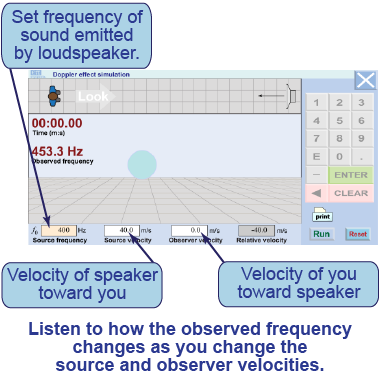| | Essential questions | | What is the Doppler effect and how is it used in technology? | |
|
The Doppler effect is the observed shift in frequency caused by relative motion between a source of sound and an observer of the sound. The frequency shift depends on the relative speed of the source and observer and on the speed of sound. By measuring the frequency shift of a reflected sound wave, it is possible to determine the velocity of the source. This is how police radar detects the speed of a moving car from a distance. 
|
Simulating the Doppler effect
 You can set the frequency of the sound source and the velocity of the source and/or the observer. In either case the simulation will play the sound you would hear if you were the observer as the speaker moved toward you, away from you, or both sequentially.
You can set the frequency of the sound source and the velocity of the source and/or the observer. In either case the simulation will play the sound you would hear if you were the observer as the speaker moved toward you, away from you, or both sequentially. - Choose a frequency of 400 Hz and a source velocity of 2 m/s (4.5 mph) and observe and record the frequencies as the speaker moves toward you and then away from you.
- Choose a source velocity of 30 m/s (67 mph) and make the same observations.
- Choose an observer velocity that moves you toward the speaker at 2 m/s and then at 30 m/s.
- Choose a source velocity of 15 m/s and an observer velocity of 15 m/s. What happens to the frequencies?
- Choose a source velocity of −15 m/s and an observer velocity of 15 m/s. What happens to the frequencies? Compare these values to your previous results.
- Choose an observer velocity of −15 m/s and a source velocity of +15 m/s. What happens to the frequencies?
- Describe three different situations in which an observer hears a sound that is Doppler-shifted to a higher frequency.
- Explain the difference between the frequency shifts you observed at velocities of 2 and 30 m/s. Express your answer in terms of the ratio of the velocity to the speed of sound (343 m/s).
- Describe the difference between moving the source and moving the observer with respect to the Doppler shift. Does it matter which is moving? To what extent?
- Can there be a situation in which both source and observer are moving and there is no Doppler shift? Explain why this is the case using the concept of relative velocity.
- Can there be a situation where the source is moving at 15 m/s yet the Doppler shift corresponds to a velocity of 30 m/s? Explain how this can be using the concept of relative velocities.

|
In this interactive simulation, you will investigate how the observed sound changes when the observer (you!) and the source (a loudspeaker) are moving relative to each other.
| |
| |
|

